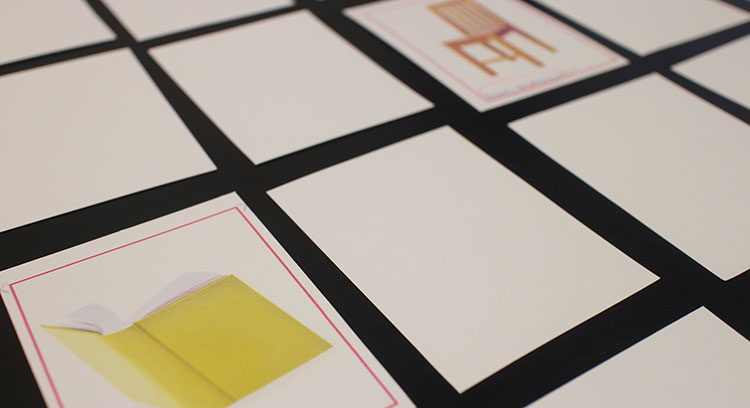B4: Rhyme Memory
1. Overview
You and your child must find rhyming pairs by gradually turning over picture cards. She will reinforce her understanding of rhymes as well as work on her memory and concentration skills.
B4: Rhyme Memory Game
2. Materials
- Script
- Rhyme Memory Game cards (each page contains 8 cards in 4 rhyming pairs)
3. Activity
This is a variation of the classic Memory Game, also known as Concentration. Before you start the game, go through the cards with your child and identify each picture, so that she understands the name used for each one (e.g., bee rather than bug). A word list is printed on each page of cards. The word list is for your use only, not for your child! Arrange the cards, face-down, in a grid. For younger children, start out with just one page of cards, or four rhyming pairs. You can add more pairs of cards as her rhyming and memory skills improve.Video: How to play Rhyme Memory Game
Your child will turn over two of the picture cards to reveal the pictures. She should name both pictures, then say whether or not they rhyme. If they do rhyme, she can remove the cards and put them in a stack off to the side. If they do not rhyme, she must turn them back over, and then you take your turn. Continue until all the rhyming pairs are matched up.
Adult: Pick two cards and turn them over. What are the pictures? Child: Fox and hat. Adult: Do fox and hat rhyme with each other? Child: Um…no. Adult: No, they don’t rhyme, so they don’t make a match. Remember where you saw the fox and the hat. Now turn them over and put them back where they were. Now it’s my turn to pick two cards. What are the pictures? Child: Nose and box. Adult: Do nose and box rhyme? Child: No. Adult: No, they don’t. Does nose or box rhyme with something we already saw? Child: Uh…fox! Fox and box!. Adult: That’s right, fox rhymes with box. Well, nose and box don’t rhyme, so I have to turn them over. Remember where they are. Now it’s your turn again. Can you remember where the fox and box cards are, to make a match?When a player makes a match, they pick up the matching cards and put them to the side. If pictures do not rhyme, turn the cards back over, and then the next person takes a turn. Continue until all the rhyming pairs are matched up. ↑ Top
4. Confidence Builder
Memory can be a difficult game for younger children (such as most three-year-olds). Here are two options for simplifying the game while still practicing rhyming. These can also be used as Confidence Builders for older children who struggle with the Memory game. Option A: If the Memory Game is too difficult, simply divide the picture cards into two face-down stacks, making sure that rhyming pairs are divided between the two stacks. Have your child pick up one card from each stack and identify them. If they make a match, she can put them to the side. If not, return the cards to the separate stacks. Continue until all cards have been matched into rhyming pairs. Option B: Start with the pictures face up and have the child find the rhyming pairs. Then put two (non-rhyming) cards face down, and give the child a third card that rhymes with one of the face-down cards. Have her turn over one of the face-down cards to see if it rhymes with the card she’s holding. ↑ Top5. Extension
To challenge your child’s memory skills, you can play with more pairs of cards, arranged in a 4-by-4 grid (16 cards, 8 rhyming pairs), 5-by-4 grid (20 cards, 10 rhyming pairs), or even a 6-by-4 grid (24 cards, 12 rhyming pairs). ↑ Top6. Small Groups (2-5 children)
Lesson Objective: Children will be able to identify and match pairs of rhyming picture cards. GELDS (Georgia Early Learning & Development Standards): CLL6.3b (Activities for this standard will be increased in difficulty to match children’s age and memory skill.) Georgia Standards of Excellence: ELAGSEKRF2.a Common Core State Standards: CCSS.ELA-LITERACY.RF.K.2.A Additional Materials:- optional: plastic tray or cookie sheet
Leave a Reply

One Response to “B4: Rhyme Memory”
Wendy Hamilton
Thank you to all the people that took time to put these activities and instructions together for teachers like myself who need these materials but are so overwhelmed. Thank you for doing this free of charge. I cannot begin to express the gratitude and pride I feel that there are still people out there that really still care about the students in our country. Thank you. Thank you. Thank you. I hope you get back 3 times more.